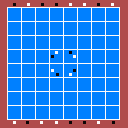





Logi-Sticks
The game requires an understanding of the basic logical operators, a chess board, 24+ small black and white objects (hereafter referred to as 'stones'), and a set of pieces. Ideally, the pieces should be Logi-Sticks pieces. The game can, however, be adequately played with Icehouse pieces.
The Pieces:
You need ten of each piece. If you're using Icehouse pieces, the base of the piece points towards the input side(s) of the square, and the remaining sides are the output sides. Icehouse piece sizes are irrelevant.
AND |
The AND piece has two input sides, and two output sides. The outputs are TRUE only if both of the input sides are TRUE. If using Icehouse pieces, this should be represented by a red piece, placed diagonally. |
OR |
The OR piece has two input sides, and two output sides. The outputs are TRUE if either of the input sides are TRUE. If using Icehouse pieces, this should be represented by a green piece, placed diagonally. |
XOR |
The XOR piece has two input sides, and two output sides. The outputs are TRUE if the input sides don't match. If using Icehouse pieces, this should be represented by a blue piece, placed diagonally. |
Passthru |
The Passthru piece has one input side, and three output sides. The outputs are the same as the input side. If using Icehouse pieces, this should be represented by a clear piece, placed ordinally. |
NOT |
The NOT piece has one input side, and three output sides. The outputs are the opposite of the input side. If using Icehouse pieces, this should be represented by a black piece, placed ordinally. |
Capacitor |
The Capacitor piece is the same as a Passthru piece, with one important difference - no piece can be played off an output of a Capacitor until it is again the turn of the player who played it. If using Icehouse pieces, this should be represented by a yellow piece, placed ordinally. |
The Starting Layout:
 On the chess board, arrange eight stones (four of each colour) around
the edges of the center four squares, such that each square has one black and
one white edge.
On the chess board, arrange eight stones (four of each colour) around
the edges of the center four squares, such that each square has one black and
one white edge.
Each player should then have black and white objects placed along the outside of their edge of the board. This can be done in several ways:
At this point, the board should look a bit like this, for a two-player game:

With more players, the other sides would also be marked with black and white stones. The edge squares with stones next to them are known as TARGET SQUARES.
If there are two players, each player gets 5 of each piece. If there are more players, the players take it in turns to take a piece from the stash, until the stash is empty.
The Goal
The idea of the game is to send the correct signal to each of the stones at your edge of the board. All signals start at the stones in the center of the board, and travel through the pieces as described in the 'pieces' section above.
White stones are considered to be "TRUE", and black stones are "FALSE".
Play
Play proceeds in turns, starting with any player. On your turn, you place a piece. Pieces can be placed only such that:
For example, at the beginning, pieces can only be played in the eight squares adjacent to the center stones, and must be facing outwards. Pieces with two inputs can be played leaving one of the inputs still open. In some cases, when one of the inputs is left open, the output is MUTABLE (always true of XOR, true of AND with a TRUE input, and true of OR with a FALSE input). Pieces can still be played using one of these MUTABLE outputs as an input - this usually means the new piece will also output MUTABLE. MUTABLE outputs are resolved into TRUE or FALSE when the missing input is added.
The game is over when all target squares have non-mutable pieces on them.
Scoring
When the game is over, each player gets one point for each of their target stones that is receiving a matching signal. The player with the most points wins. In the event of a tie, the player with more TRUE target stones receiving a matching signal wins. If it's still a tie, the player with more FALSE target stones to begin with wins. If it's still a tie, that's it, it's a tie.
[ Return to games | To index ]